Glutamate Transporters EAAT2 and EAAT5 Differentially Shape Synaptic Transmission from Rod Bipolar Cell Terminals
- PMID: 35523583
- PMCID: PMC9121915
- DOI: 10.1523/ENEURO.0074-22.2022
Glutamate Transporters EAAT2 and EAAT5 Differentially Shape Synaptic Transmission from Rod Bipolar Cell Terminals
Abstract
Excitatory amino acid transporters (EAATs) control visual signal transmission in the retina by rapidly removing glutamate released from photoreceptors and bipolar cells (BCs). Although it has been reported that EAAT2 and EAAT5 are expressed at presynaptic terminals of photoreceptors and some BCs in mammals, the distinct functions of these two glutamate transporters in retinal synaptic transmission, especially at a single synapse, remain elusive. In this study, we found that EAAT2 was expressed in all BC types while coexisting with EAAT5 in rod bipolar (RB) cells and several types of cone BCs from mice of either sex. Our immunohistochemical study, together with a recently published literature (Gehlen et al., 2021), showed that EAAT2 and EAAT5 were both located in RB axon terminals near release sites. Optogenetic, electrophysiological and pharmacological analyses, however, demonstrated that EAAT2 and EAAT5 regulated neurotransmission at RB→AII amacrine cell synapses in significantly different ways: EAAT5 dramatically affected both the peak amplitude and kinetics of postsynaptic responses in AIIs, whereas EAAT2 had either relatively small or opposite effects. By contrast, blockade of EAAT1/GLAST, which was exclusively expressed in Müller cells, showed no obvious effect on AII responses, indicating that glutamate uptake by Müller cells did not influence synaptic transmission from RB terminals. Furthermore, we found that temporal resolution at RB→AII synapses was reduced substantially by blockade of EAAT5 but not EAAT2. Taken together, our work reveals the distinct functions of EAAT2 and EAAT5 in signal transmission at RB ribbon synapses.
Keywords: amacrine cell; bipolar cell; glutamate transporter; retina; synaptic transmission; temporal resolution.
Copyright © 2022 Tang et al.
Figures
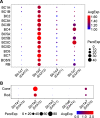
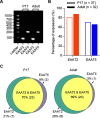

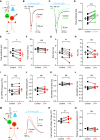
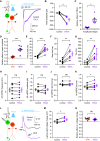


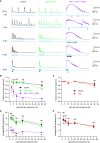
Similar articles
-
Pharmacological inhibitions of glutamate transporters EAAT1 and EAAT2 compromise glutamate transport in photoreceptor to ON-bipolar cell synapses.Vision Res. 2014 Oct;103:49-62. doi: 10.1016/j.visres.2014.07.020. Epub 2014 Aug 22. Vision Res. 2014. PMID: 25152321 Free PMC article.
-
The glutamate transporter EAAT5 works as a presynaptic receptor in mouse rod bipolar cells.J Physiol. 2006 Nov 15;577(Pt 1):221-34. doi: 10.1113/jphysiol.2006.118281. Epub 2006 Sep 14. J Physiol. 2006. PMID: 16973698 Free PMC article.
-
Light-evoked glutamate transporter EAAT5 activation coordinates with conventional feedback inhibition to control rod bipolar cell output.J Neurophysiol. 2020 May 1;123(5):1828-1837. doi: 10.1152/jn.00527.2019. Epub 2020 Apr 1. J Neurophysiol. 2020. PMID: 32233906 Free PMC article.
-
EAAT5 Glutamate Transporter-Mediated Inhibition in the Vertebrate Retina.Front Cell Neurosci. 2021 May 6;15:662859. doi: 10.3389/fncel.2021.662859. eCollection 2021. Front Cell Neurosci. 2021. PMID: 34025361 Free PMC article. Review.
-
[Role of glutamate transporters in excitatory synapses in cerebellar Purkinje cells].Brain Nerve. 2007 Jul;59(7):669-76. Brain Nerve. 2007. PMID: 17663137 Review. Japanese.
Cited by
-
Metabolic dysfunction promoted by mitochondrial DNA mutation burden drives retinal degeneration.bioRxiv [Preprint]. 2025 Jul 31:2025.07.30.667736. doi: 10.1101/2025.07.30.667736. bioRxiv. 2025. PMID: 40766447 Free PMC article. Preprint.
-
EAAT5 glutamate transporter rapidly binds glutamate with micromolar affinity in mouse rods.J Gen Physiol. 2023 Sep 4;155(9):e202313349. doi: 10.1085/jgp.202313349. Epub 2023 Jul 21. J Gen Physiol. 2023. PMID: 37477643 Free PMC article.
-
The architecture of invaginating rod synapses slows glutamate diffusion and shapes synaptic responses.J Gen Physiol. 2025 May 5;157(3):e202413746. doi: 10.1085/jgp.202413746. Epub 2025 Feb 28. J Gen Physiol. 2025. PMID: 40019452
-
Synapse Dysfunctions in Multiple Sclerosis.Int J Mol Sci. 2023 Jan 13;24(2):1639. doi: 10.3390/ijms24021639. Int J Mol Sci. 2023. PMID: 36675155 Free PMC article. Review.
-
Identification of Differentially Expressed Genes in the Hypothalamus of Broilers Under Heat Stress Using Transcriptome Analysis.Animals (Basel). 2025 Feb 10;15(4):502. doi: 10.3390/ani15040502. Animals (Basel). 2025. PMID: 40002984 Free PMC article.
References
-
- Barnett NL, Pow DV (2000) Antisense knockdown of GLAST, a glial glutamate transporter, compromises retinal function. Invest Ophthalmol Vis Sci 41:585–591. - PubMed
-
- Blondel VD, Guillaume JL, Lambiotte R, Lefebvre E (2008) Fast unfolding of communities in large networks. J Stat Mech 2008:P10008. 10.1088/1742-5468/2008/10/P10008 - DOI
Publication types
MeSH terms
Substances
LinkOut - more resources
Full Text Sources
Molecular Biology Databases
